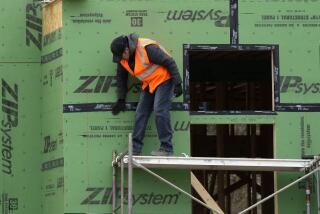Personal saving rate falls in November
- Share via
Despite the ballyhooed record retail sales over Thanksgiving, consumer spending for all of November turned out to be rather ho-hum.
Personal spending overall edged up a modest 0.1% in November for the second straight month, the Commerce Department said Friday. That, coupled with other data suggesting weaker manufacturing shipments, tempered the recently more optimistic outlook for the economy.
“Consumers will not lead the recovery on a consistent basis,” Moody’s Analytics’ economist Scott Hoyt said in a research note. “They simply do not have the resources.”
The data fell short of analyst projections for a gain of 0.3%, and the slower-than-projected rise in consumer spending came as personal income barely grew last month. And after-tax income, which is the money that is available to spend or save, actually fell a bit in November.
With the rate of spending outpacing income gains, households saved a little less as they bought cars and other goods and services.
The government said the personal saving rate — the percentage of after-tax income that’s not spent — fell to 3.5% in November from 3.6% in October. As recently as June, households were socking away about 5% of their earnings.
Until July, the saving rate had consistently been at 4.5% or higher since late 2009. The latest saving rate is still better than the housing bubble months of 2005-07, when it generally hovered between 1% and 2%.
Even so, the recent drop in saving indicates that although consumers want to buy things they put off during the shaky recovery, they don’t have the jobs and income growth to support a big ramp-up in purchases.
With an unemployment rate of 8.6% and millions of people who have had to take part-time jobs, American workers don’t have much bargaining power. The largest single component of incomes is wages, and those fell slightly in November.
There are signs that the job market is looking up, however. Fewer people are filing for unemployment benefits, and surveys have found a pickup in employers’ hiring plans.
For consumers, Congress’ approval Friday of a temporary extension of a payroll tax cut and federal jobless benefits will help prop up their spending at least through the end of February. What’s more, consumers are finding it a little easier to get credit, and many have reduced financing costs on mortgages and other debt thanks to historically low interest rates.
Many families are still carrying a hefty amount of debt, which will limit their spending. And others are constrained by depressed home values.
Some analysts think that the housing market will stabilize next year and give a lift to consumption and the broader economy. On Friday, the government said sales of new single-family homes rose in November for the third straight month.
More to Read
Inside the business of entertainment
The Wide Shot brings you news, analysis and insights on everything from streaming wars to production — and what it all means for the future.
You may occasionally receive promotional content from the Los Angeles Times.











